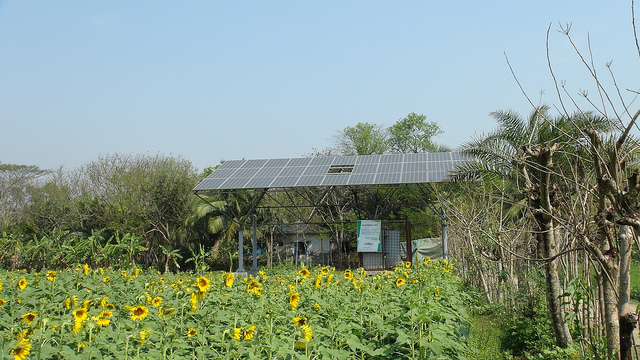Our newest blog comes from Dr Helena Wright, a former PhD student at Imperial College London’s Centre for Environmental Policy, who now works at environmental think-tank E3G. In March 2015 Helena travelled to Bangladesh to learn more about one of the fastest growing solar markets in the world. With support from the Energy Futures Lab, she filmed the documentary film, Solar Nation and here she tells us a bit more about the making of the film.
Bangladesh has around four million solar panels and rising – an impressive statistic that has brought light into the homes of many rural families.

This film brings together the voices of women who have installed solar panels, and people promoting solar energy across the country, from professors to bankers. I interviewed a number of different people including Marjina, from Khulna District. She told me that after installing her solar panel, she was so happy with it that she recommended solar energy to more than ten other families, and also took training on how to maintain and fix her neighbours’ solar panels.
I also met and interviewed the Governor of the Central Bank, who explained that Bangladesh is now trialling different types of solar technology including solar irrigation. This is important in a country where both energy and fresh water are scarce and which suffers from the impacts of climate change on water supplies.

This is an overwhelmingly positive story, and there have been very little problems with the panels. The solar programme in Bangladesh was initiated by the World Bank but has since become self-sustaining, as people get microfinance loans to buy the panels. Everyone I interviewed explained that solar energy ends up considerably cheaper than using kerosene lamps for lighting – the main alternative in off-grid areas.

Solar energy now benefits around 18 million people in a country of around 160 million, so while it has benefitted the country hugely, there is still a long way to go and many more people that could benefit. The goal is to shed light on people’s experiences and explore the impacts on people’s lives. With over 1 billion people across the world still lacking access to electricity – what can we learn from Bangladesh’s solar revolution?
In the same way that Bangladesh has experienced a mobile phone revolution, and avoided unreliable telephone lines, will the country be able to fast track to cleaner alternative energy, leapfrogging fossil-fuel dependent and polluting forms of energy? With similar developments taking place in several countries in Africa, I suspect that we will find out.
This film can be viewed online at: https://solarnationfilm.com/watch/ and on YouTube.

i like the way you presented the information out there thanks .
LikeLike
This is encouraging. In this day and age where the issues of climate change are ever visible in terms of diminishing water reserves as well as increase in ambient temperatures the onus is on every one to ensure environmental preservation through the employment of Environmental friendly and sustainable means of energy generation.
LikeLike